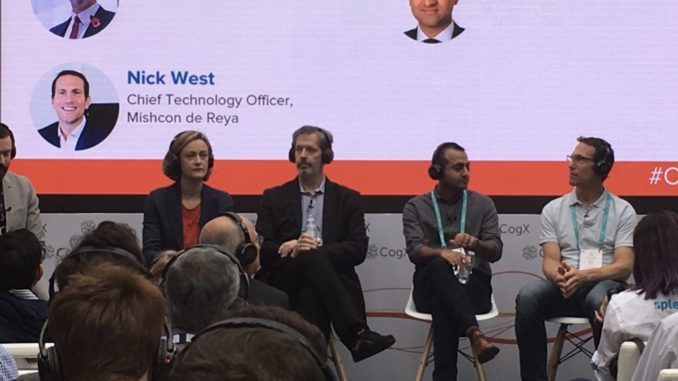
Experts in the field of legal automation and AI at UK tech festival CogX yesterday said that although the current level of automation in the law was ‘tiny’ that ‘there is only one direction it can go’ and that is up in terms of growth and adoption rates across the market.
The comments came after two panels on legal AI’s impact so far on the world of lawyers, and in this case primarily from Nick West, CTO, at Mishcon de Reya and Partha Mudgil, COO at Nakhoda, Linklaters’ home-grown AI platform.
Artificial Lawyer asked the question: ‘How far has automation got in law firms in terms of total work activity that has been automated, (whether using AI or other technology)? And where is it headed?’
Mudgil noted that even with all the activity at Linklaters in this area, that when it came to automation of transactional work then ‘it’s about 1% at present’ in terms of the amount of work that was moving out of human hands. That said, Linklaters is a £1.3 billion revenue law firm, so even if 1% of its total output was provided by automation then this would be noteworthy.
‘Tech [in law firms] has come a long way, but [automation of legal processes] is a five to fifty year problem,’ said Mudgil. By way of example he added: ‘Most doc creation is still manual.’
And that time frame certainly could be true if we are looking at total automation of whole ‘legal production lines’, but what we are seeing now is partial automation of aspects of the ‘manufacturing’ process, which is perhaps all we can expect at present, but which can be built upon successively.
West agreed that when it comes to truly automating large parts of legal production methods then we are really just at the beginning.
‘It’s tiny at the moment in terms of automation of processes,’ West noted.
Like Linklaters, Mishcon is a law firm that has put considerable time and effort into legal tech, and is now on its second cohort of startups for its MDR LAB incubator. It also makes use of legal AI tools such as Kira Systems.
But, even with all this West said: ‘Very often lawyers still use the same tools they did 25 years ago.’
He also noted wryly that for some lawyers having ‘track changes is cutting edge’, even though it’s something Microsoft Word provided in the early 1990s.
West added that when you looked across the entire workflow of a law firm, from client acquisition to performing work for the client, to later stages such as review of old contracts, then the total amount of this activity that was automated so far was indeed very small, especially in terms of joined up automated processes.
He also observed that trying to change how lawyers worked was always going to be a challenge as you were not starting from scratch, you were ‘rebuilding’ a business’s work processes that were already functioning. And arguably from the private practice lawyer’s view, working very well, one could add.
However, West was optimistic: ‘There is only got one direction this can go.’
And, in another optimistic note, Emily Foges, CEO of legal AI company, Luminance, added that there were law firm clients that used automated doc review for every M&A transaction, not just the occasional one.
This suggests that at least for some law firms that the total percentage of automated activity is already starting to become noticeable.
Overall, the view is that automation, via AI, or other technology, now has a visible foothold in the legal world, but we are truly only at the beginning of the journey. And, as West says, things can only grow upwards from here.
(Photo credit: RT. Showing Left to Right, Emily Foges – CEO, Luminance, Gary Gallen – rradar, Partha Mudgil COO, Nakhoda – Linklaters and Nick West – CTO, Mishcon de Reya.)
2 Trackbacks / Pingbacks
Comments are closed.